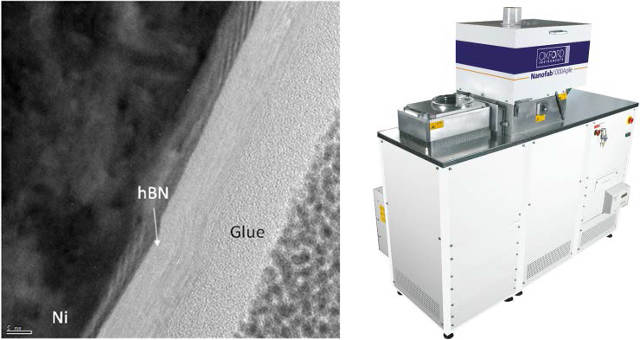As developments in graphene and 2D materials technology continue to increase, research institutes globally are investing in Oxford Instruments’ leading plasma processing Nanofab® equipment using CVD, PECVD and ICPCVD techniques to further their work in this important area.
Multiple orders have recently been received from prestigious research centres in Europe and the USA, including the United States Naval Research Laboratory (NRL) and University College, London.
 Cross-sectional TEM image of a hBN film on Ni substrate grown by CVD on the Nanofab1200 system. (TEM image courtesy of Dr. Peter Werner, Max Planck Institute of Microstructure Physics)
Cross-sectional TEM image of a hBN film on Ni substrate grown by CVD on the Nanofab1200 system. (TEM image courtesy of Dr. Peter Werner, Max Planck Institute of Microstructure Physics)
Chemical Vapour Deposition (CVD) has been one of the most successful techniques for the fabrication of nanostructured materials such as graphene, carbon nanotubes and other 1D and 2D nanomaterials. The Nanofab is ideal for this field of research as it combines several essential features for high performance growth such as a high temperature heater capable of processing up to 200 mm wafers, shower head technology, automatic load lock for wafer handling as well as flexible options for liquid/solid precursor delivery.
Prof Zheng-Xiao Guo, of University College London said, “We recently placed an order for a Nanofab, chosen for its operating capability, process control, and great flexibility for further modification and upgrades. We also like the fact that we will be provided with dedicated after-sales support, not only in running the system, but also in enhancing the scope of our applications.”
Dr David Haynes, Sales and Marketing Director at Oxford instruments Plasma Technology commented, “In recent years there has been a great increase in graphene R&D worldwide, due to the impact that this area of research is expected to exert on tomorrow’s technologies and world economy. Several national research projects as well as industrial companies are now active in graphene production and applications, and more are set to follow, and we are extremely pleased that UCL, UK and NRL, USA amongst others have chosen our Nanofab systems.”
About Oxford Instruments plc
Oxford Instruments designs, supplies and supports high-technology tools and systems with a focus on research and industrial applications. Innovation has been the driving force behind Oxford Instruments' growth and success for over 50 years, and its strategy is to effect the successful commercialisation of these ideas by bringing them to market in a timely and customer-focused fashion.
The first technology business to be spun out from Oxford University, Oxford Instruments is now a global company with over 2300 staff worldwide and is listed on the FTSE250 index of the London Stock Exchange (OXIG). Its objective is to be the leading provider of new generation tools and systems for the research and industrial sectors with a focus on nanotechnology. Its key market sectors include nano-fabrication and nano-materials. The company’s strategy is to expand the business into the life sciences arena, where nanotechnology and biotechnology intersect
This involves the combination of core technologies in areas such as low temperature, high magnetic field and ultra high vacuum environments; Nuclear Magnetic Resonance; x-ray, electron, laser and optical based metrology; atomic force microscopy; optical imaging; advanced growth, deposition and etching.
Oxford Instruments aims to pursue responsible development and deeper understanding of our world through science and technology. Its products, expertise, and ideas address global issues such as energy, environment, security and health.
About Oxford Instruments Plasma Technology
Oxford Instruments Plasma Technology offers flexible, configurable process tools and leading-edge processes for the precise, controllable and repeatable engineering of micro- and nano-structures. Our systems provide process solutions for the etching of nanometre sized features, nanolayer deposition and the controlled growth of nanostructures.
These solutions are based on core technologies in plasma-enhanced deposition and etch, ion-beam deposition and etch, atomic layer deposition, deep silicon etch and physical vapour deposition. Products range from compact stand-alone systems for R&D, through batch tools and up to clustered cassette-to-cassette platforms for high-throughput production processing.